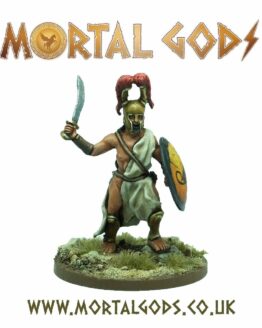Peltasts carried a crescent-shaped wicker shield called a pelte as their main protection, which they are named after. Sources say the pelte was rimless and covered in goat or sheepskin with some implying that the shield could also be round, but in art it is usually shown as crescent-shaped. Peltasts’ weapons consisted of several javelins (akontia), which may have had straps to allow more force to be applied to a throw.
The style of fighting used by peltasts originated in Thrace with the first Greek peltasts recruited from the Greek cities of the Thracian coast. Generally depicted on vases and in other images as wearing the typical Thracian costume, most distinctive of which is the Phrygian cap made of fox-skin and with ear flaps. They also usually wear a patterned tunic, fawnskin boots and a long cloak, called a zeira, decorated with a bright, geometric, pattern.
Peltast warriors began to appear in Greek depictions of Persian troops equipped in the same fashion as Greek and Thracian peltasts but dressed in typically Persian army uniforms. As well as javelin they often carried a light axe, known as a sagaris, as a sidearm.
It has been suggested that these troops were known in Persian as takabara and their shields as taka. The Persians may have been influenced by Greek and Thracian peltasts. Another alternative source of influence would have been the Anatolian hill tribes, such as the Corduene, Mysians or Pisidians.
Pack contains three Mortal Gods Miniatures. Made from resin and is supplied with a round MDF group base. May require assembly.





